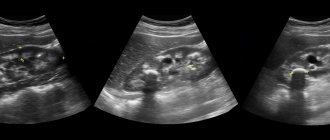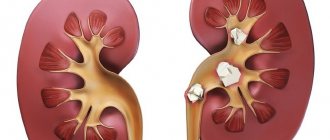Nephritic syndrome
Nephritic syndrome is an inflammation of the glomeruli of the kidneys with signs of azotemia, that is, a decrease in glomerular filtration, with severe proteinuria, hematuria and retention of salts and fluids in the body with the subsequent development of arterial hypertension. It is necessary to distinguish between nephrotic syndrome and nephritic syndromes. Both of them are not a diagnosis, but merely determine the condition of various diseases. Defined generally, nephrosis is the general definition of kidney damage, and nephritis is inflammation of the kidneys. Sometimes nephritic syndrome is defined as glomerulonephritis, but this is incorrect, since nephritic syndrome can be a manifestation of glomerulonephritis, but this is not the same thing, since it can also be a manifestation of other diseases. Nephritic syndrome is not a disease or a diagnosis, it is a set of symptoms similar to nephritis, often acute. Nephritic syndrome can be acute, subacute and chronic.
Pathogenesis and causes In the model of development of nephritic syndrome, post-streptococcal or any other form of nephritis is almost always present. Moreover, of all streptococci, only B-hemolytic streptococcus can cause the development of nephritic syndrome. Usually the syndrome, even acute, begins to develop gradually and, as a rule, imperceptibly, at some stage of nephritis and only under the influence of some external factors, for example, hypothermia, streptococcal sore throat, and so on, begins to manifest itself violently. This onset of nephritic syndrome is called acute, since the symptoms appear suddenly, but it should be understood that the development process itself probably began much earlier. In some cases, the process increases gradually and then we are talking about subacute nephritic syndrome. If symptoms appear and disappear at varying intervals, usually several months or even every six months, then such nephritic syndrome is considered to be chronic recurrent. The second cause of the development of nephritic syndrome can be various autoimmune diseases, for example systemic lupus erythematosus, vasculitis, and so on. Nephritic syndrome develops as a result of the accumulation of complement glomerular cells on the basement membrane. Increased excretion of hydrogen ions or a toxic factor of a non-infectious nature can also cause the formation of nephritic syndrome.
Causes of nephrotic syndrome
The immunological concept of the development of nephrotic syndrome is widespread, which is due to the occurrence of the syndrome as a result of autoimmune diseases and allergic reactions. The connection of antibodies with internal or external antigens promotes the formation of circulating immune complexes in the blood, the sedimentation of which leads to an inflammatory process and impaired circulation in the capillaries.
There are two types of antigens - exogenous (viruses, bacteria) and endogenous (genetic heredity). The severity of kidney destruction depends on the structure and duration of the effect on the body. Activated processes against the background of immune reactions provoke the formation of inflammatory processes and a negative effect on the basement membrane of the capillary glomeruli, which leads to their increased penetration.
At the initial stage of nephrotic syndrome, mechanisms operate that cause injury to the membranes and cells of the glomeruli, inflammatory processes and immunoallergic reactions. Causes of nephrotic syndrome:
- complex diseases (affecting the whole body):
- rheumatoid arthritis - inflammation of connective tissue (joints);
- lupus erythematosus is a pathology that affects the internal organs and skin of a person;
- Granulomatosis is a disease that promotes the formation of nodules.
- infectious diseases:
- a source of putrefaction that goes undiagnosed for a long time;
- tuberculosis;
- endocarditis - inflammation of the lining of the heart from the inside, which progresses as a result of infection;
- Human immunodeficiency virus (HIV) is a viral infection of elements of the immune system.
- liver diseases (hepatitis B and C);
- blood cancer - dysfunction of the bone marrow, which leads to an increase in the number of cells in the blood;
- diabetes mellitus - improper metabolism of sugar, which causes an increase in its concentration in the blood;
- heart failure - damage to the blood flow in the kidneys caused by the inability of the heart to pump blood in the right amount;
- taking antibiotics, anticonvulsants and anti-inflammatory medications;
- allergies, heavy metal poisoning;
- tumors (lymphoma, melanoma);
- chronic pathologies;
- mixed diseases.
Description
Nephrotic syndrome is a pathological condition of the kidneys, which is characterized by edema and loss of protein in the urine.
Occurs in primary and secondary nephropathies. The code in ICD-10 is N04. Nephrotic syndrome develops in many dissimilar diseases. It is diagnosed in patients with autoimmune, immunoinflammatory, infectious, toxic, metabolic or hereditary kidney damage. The syndrome can be primary or secondary. The prevalence of the primary variant is 1 case per 6 thousand people. Its reasons are:
- idiopathic glomerulonephritis;
- congenital kidney damage;
- hereditary predisposition;
- primary amyloidosis (nephrotic form).
Secondary nephrotic syndrome is a more common variant. Diagnosed more often in adults. His reasons:
- systemic connective tissue diseases;
- rheumatoid arthritis;
- hemorrhagic vasculitis;
- infective endocarditis;
- chronic suppurative diseases;
- tuberculosis;
- syphilis;
- parasitic diseases;
- nephropathy in pregnant women;
- diabetic glomerulonecrosis.
The final urine is formed due to a complex set of processes in the kidneys - filtration, reabsorption, concentration and secretion. Filtration occurs in the glomeruli, which are branches of the afferent arterioles. The basis of nephrotic syndrome is a dysfunction of the glomerular filter: its walls become excessively permeable to plasma proteins due to damage to the capillary walls. The most typical immune pathological mechanisms. In other words, the glomerulus is damaged due to activation of the complement system, interaction of antigen with antibody, and deposition of immune complexes on the basement membrane. Immune inflammation and massive proteinuria (loss of protein in the urine) develop.
Another option for damage to the renal glomerulus is microangiopathy. This disorder develops due to a disorder of nervous regulation; it manifests itself, for example, in diabetic glomerulosclerosis. Also, the cause of pathology of renal glomerular filtration can be: amyloid deposits, toxic effects of drugs and metal salts, infections.
Symptoms of nephrotic syndrome
The signs of nephrotic syndrome are determined by the form, characteristics and nature of the disease, which caused the appearance of this pathology.
The following symptoms of nephrotic syndrome are observed:
- Edema, the specificity of which is the concentration of a large amount of fluid in the tissues. Initially, it forms on the face (cheeks, around the eyes), and after a while it spreads to other parts of the body. Excessive swelling can cause anasarca (swelling of the entire body) and ascites (fluid in the abdominal cavity).
- Changes in the skin and hair structure, resulting in brittleness and dryness.
- Anemia is a disorder of erythropoietin metabolism, which promotes the production of red blood cells in the bone marrow. Characteristic signs of anemia may include shortness of breath, dizziness, pallor and weakness.
- Disorder of the general condition of the body. Together, swelling and anemia lead to impaired activity, which can cause severe headaches.
- Dyspeptic symptoms (disruption of the normal functioning of the stomach) - the release of nitrogen metabolism products through the mucous membrane of the gastrointestinal tract, the special signs of which may be bloating, lack of appetite and nausea.
- A change in the volume of urine caused by impaired blood flow in the kidneys, which leads to a decrease in the amount of urine excreted, can trigger the development of kidney failure. Due to the abundance of protein and fats, urine becomes cloudy in color.
Diagnosis of nephrotic syndrome
Diagnosis of nephrotic syndrome is based on symptoms and clinical and laboratory tests, which consist of a number of activities and procedures:
- anamnesis is the collection of information through a conversation with the patient during a medical consultation, where data is clarified about the presence of infectious and chronic diseases, the presence of kidney pathologies among relatives, when and what the first signs of the disease appeared, whether the patient had previously suffered from this disease;
- examination of the patient’s condition by inspection and palpation (condition of the skin, joint system, nature and presence of edema);
- a blood test, which consists of the following set of tests: a general blood test, which will help determine the content of leukocytes and platelets, the level of hemoglobin and red blood cells (typical of anemia);
- biochemical blood test: allows you to study the functioning of internal organs and metabolic processes in the body. During the study, it is possible to diagnose changes in kidney function, cholesterol and protein metabolism;
- An immunological blood test helps determine the number, volume and activity of immune cells, as well as the presence of antibodies in the blood. Before taking this test, the patient is not recommended to drink alcohol or exercise.
- general urinalysis: allows you to determine the synthetic composition and physical properties of urine;
- X-rays of light;
Folk remedies
Photo: elle.ru
The use of traditional methods of therapy is possible outside periods of exacerbation, after completion of drug treatment and discharge from the hospital. It is important to remember that herbal components can enhance the effect of some medications, for example, diuretics, and lead to complications, so the use of herbs is permissible only after completing the medication!
Lingonberries, rose hips and cranberries, juniper and fennel fruits, parsley and birch leaves, birch buds, and horsetail herb will help restore kidney function. You can make fruit drinks from the berries. Pumpkin and cucumber juices will also be beneficial. They are taken on an empty stomach several times a day. In the absence of contraindications, it is permissible to take infusions and teas from kidney pharmacies.
All folk remedies should be used after consultation with a doctor.
The information is for reference only and is not a guide to action. Do not self-medicate. At the first symptoms of the disease, consult a doctor.
Treatment of nephrotic syndrome
Treatment for nephrotic syndrome depends on what caused the disease. In addition to the main drugs that are intended to eliminate the syndrome, treatment is prescribed that is focused on eliminating the cause of the disease.
During the treatment of nephrotic syndrome, the patient may be prescribed the following drugs:
- Glucocorticosteroids, they have antiallergic, anti-edematous and anti-inflammatory effects. Taking such medications, the patient may experience sleep disturbances, increased appetite, and an attack of psychosis.
- Cytostatics can be prescribed either independently or simultaneously with glucocorticosteroids. This drug is prescribed when hormonal therapy is not effective, as well as for people with contraindications to the use of glucocorticosteroids.
- Immunosuppressants are forced suppression of the immune system in diseases of an autoimmune nature, which is aimed at producing antibodies.
- Diuretics: aimed at reducing swelling by increasing urine production.
- Infusion therapy is the intravenous infusion of special drugs into the bloodstream, which normalizes metabolism and blood circulation.
- Antibiotics: help eliminate the development of viruses and infections.
- Compliance with a diet, the severity of which depends on the characteristics of edema, the ability of the kidneys to remove nitrogen-containing residues and the level of protein in the blood.
Medicines
Photo: rg.ru
Drug therapy is carried out under strict control of the patient’s well-being and monitoring of laboratory parameters. In addition to medications aimed at treating the disease that caused nephrotic syndrome, patients are prescribed:
- Diuretics. Diuretics are selected depending on the severity of renal dysfunction. For mild symptoms, thiazides are indicated. If they are ineffective, they are replaced with loop diuretics. During treatment, albumin and potassium levels, blood pressure levels, and glomerular filtration rate are monitored.
- ACE inhibitors and ARBs. Angiotensin-converting enzyme inhibitors and angiotensin II receptor blockers reduce intraglomerular pressure, reducing urinary protein loss by 50%. Therapy begins with low dosages, which are gradually increased to a maximum. Regular monitoring of creatinine and potassium concentrations in the blood is performed. Therapy with these medications has a high risk of side effects, so the advisability of its use is determined individually.
- Lipid-lowering drugs. To reduce the level of lipids in the blood is necessary in severe nephrotic syndrome, when it is not possible to slow down the loss of protein in the urine. Low dosage statins are initially prescribed.
- ACE inhibitors. These drugs are indicated for arterial hypertension. They can be replaced with ARB inhibitors, and if there is no positive effect, with calcium channel blockers. Beta blockers are used to eliminate tachycardia.
Prognosis and prevention for nephrotic syndrome
In case of late diagnosis and incorrectly selected treatment, nephrotic syndrome can provoke various kinds of complications. This may include: growth retardation, lack of protein in the body, brittle nails and hair, muscle pain and weakness, and baldness.
The main threat of nephrotic syndrome will be the body's increased sensitivity to inflammatory processes, which is caused by viruses, bacteria and microorganisms. This is due to decreased body defense as a result of loss of immunoglobulins.
Nephrotic syndrome can cause the following diseases:
- hypertension, in case of fluid retention in the body and kidney dysfunction;
- anorexia is a loss of appetite that is caused by swelling of the abdominal cavity (ascites);
- chronic edema;
- hypocalcemia, which occurs as a result of taking large amounts of steroid drugs;
- venous thrombosis;
- atherosclerosis;
- hypovolemia is a decrease in plasma fluid in tissues. It is accompanied by abdominal pain and cold extremities.
In case of late diagnosis and incorrectly selected treatment, nephrotic syndrome can provoke various kinds of complications. This may include: growth retardation, lack of protein in the body, brittle nails and hair, muscle pain and weakness, and baldness.
The main threat of nephrotic syndrome will be the body's increased sensitivity to inflammatory processes, which is caused by viruses, bacteria and microorganisms. This is due to decreased body defense as a result of loss of immunoglobulins.
Nephrotic syndrome can cause the following diseases:
- hypertension, in case of fluid retention in the body and kidney dysfunction;
- anorexia is a loss of appetite that is caused by swelling of the abdominal cavity (ascites);
- chronic edema;
- hypocalcemia, which occurs as a result of taking large amounts of steroid drugs;
- venous thrombosis;
- atherosclerosis;
- hypovolemia is a decrease in plasma fluid in tissues. It is accompanied by abdominal pain and cold extremities.
Prevention
The main preventive measure for nephrotic syndrome will be timely diagnosis of the disease and qualified treatment of renal complications and systemic diseases of the body that contribute to the formation of this pathology. During treatment, it is very important to follow the doctor’s prescription and recommendations, which include following a diet, avoiding alcohol and limiting physical activity.
A pregnant woman with a family history of nephrotic syndrome is recommended to undergo antenatal diagnostics to determine the congenital pathology of the fetus.
Sources
- Nephrotic syndrome /N. Jaipaul. – 2019
- Clinical guidelines for providing medical care to children with nephrotic syndrome /A. A. Baranov. – 2015.
- Nephrotic syndrome. Textbook / L.E. Rudakova, F.K. Rakhmatullov. Penza State University. – 2011.
- Proteinuria and nephrotic syndrome / Yu. S. Milovanov. – 2009.
- Differential diagnosis for nephrotic syndrome /Mironova N.A., Aleutskaya O.N., Kornilov L.Ya. – 2013.
- Nephrotic syndrome in children: definition and principles of therapy / S. V. Belmer, A. V. Malkoch. – 2004.







